Pharmacological investigation on the anti-oxidant and anti-inflammatory activity of N-acetylcysteine in an ex vivo model of COPD exacerbation
- PMID: 28118826
- PMCID: PMC5260037
- DOI: 10.1186/s12931-016-0500-y
Pharmacological investigation on the anti-oxidant and anti-inflammatory activity of N-acetylcysteine in an ex vivo model of COPD exacerbation
Abstract
Background: Oxidative stress is recognized to be one of predisposing factor in the pathogenesis of COPD. The oxidant/antioxidant imbalance is significantly pronounced in patients with COPD exacerbation. N-acetylcysteine (NAC) seems to be able to reduce COPD exacerbations by modulating the oxidative stress in addition to its well-known mucolytic activity, but there are discordant findings on the actual anti-oxidant activity of NAC.
Methods: The anti-oxidant effect of NAC and its impact on the inflammatory response have been pharmacologically characterized on a human ex vivo model of COPD exacerbation induced by lipopolysaccharide (LPS).
Results: NAC prevented the desensitization induced by LPS incubation on the contractile tone in linear concentration-response manner. Concentrations of NAC ≥1 μM reduced the pro-oxidant response (peroxidase activity, hydrogen peroxide, malondialdehyde, nitric oxide), and improved the anti-oxidant response (total anti-oxidant capacity, glutathione, superoxide dismutase) induced by LPS. Lower concentrations of NAC (<1 μM) did not modulate the bronchial oxidative imbalance. Concentrations of NAC ≥300 μM inhibited the inflammatory response (release of IL-1β, IL-8, and TNF-α) of human airways induced by the overnight stimulation with LPS, whereas lower concentrations of NAC (≥1 μM) were sufficient to reduce the release of IL-6 elicited by LPS. Both the anti-oxidant effect and the anti-inflammatory effect of NAC were inversely correlated with the release of NKA.
Conclusions: The findings of this study suggest that NAC may have a role in modulating the detrimental effect induced by LPS in course of COPD exacerbation. It may elicit both anti-oxidant and anti-inflammatory effects when administered at high concentrations.
Keywords: Anti-inflammatory effect; Anti-oxidant effect; COPD; Lipopolysaccharide; N-acetylcysteine.
Figures
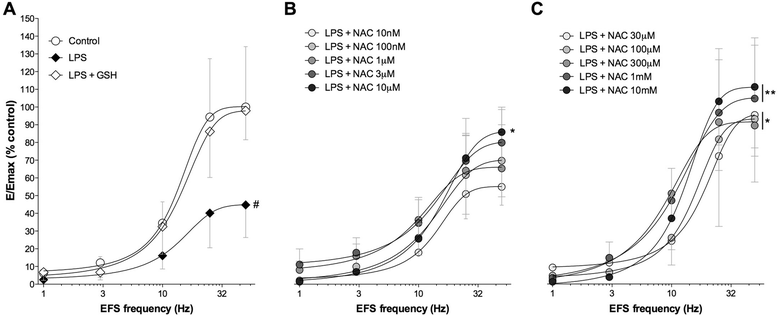
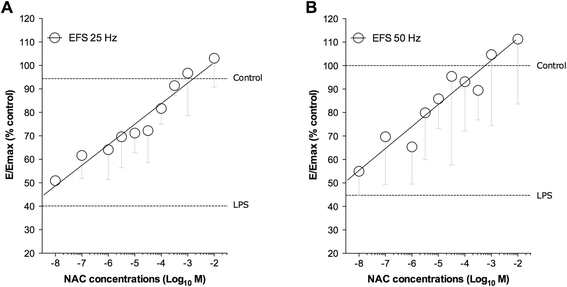
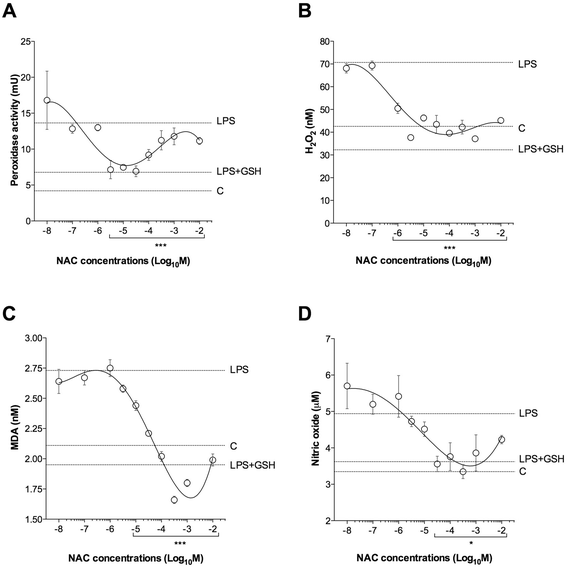

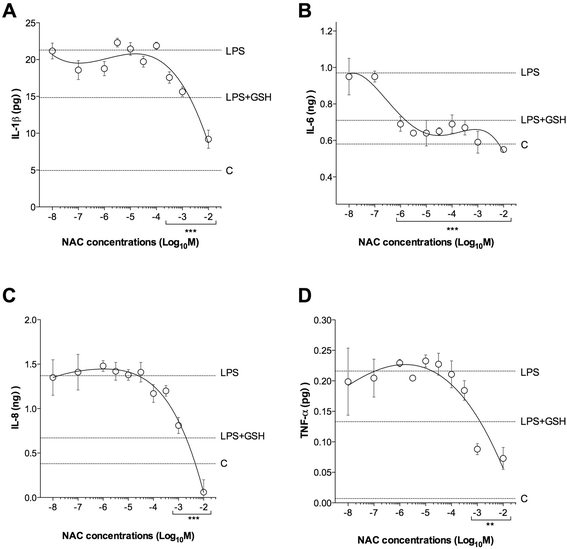
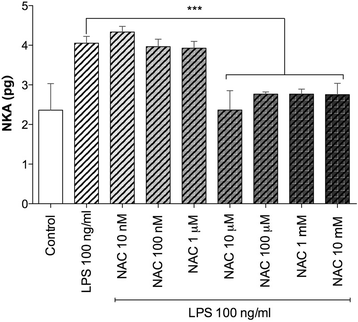
Similar articles
-
N-Acetylcysteine protects human bronchi by modulating the release of neurokinin A in an ex vivo model of COPD exacerbation.Biomed Pharmacother. 2018 Jul;103:1-8. doi: 10.1016/j.biopha.2018.04.011. Epub 2018 Apr 24. Biomed Pharmacother. 2018. PMID: 29635121
-
New developments in the treatment of COPD: comparing the effects of inhaled corticosteroids and N-acetylcysteine.J Physiol Pharmacol. 2005 Sep;56 Suppl 4:135-42. J Physiol Pharmacol. 2005. PMID: 16204787 Clinical Trial.
-
Update on the pathological processes, molecular biology, and clinical utility of N-acetylcysteine in chronic obstructive pulmonary disease.Int J Chron Obstruct Pulmon Dis. 2014 Aug 6;9:825-36. doi: 10.2147/COPD.S51057. eCollection 2014. Int J Chron Obstruct Pulmon Dis. 2014. PMID: 25125976 Free PMC article. Review.
-
Oxidation pathway and exacerbations in COPD: the role of NAC.Expert Rev Respir Med. 2016;10(1):89-97. doi: 10.1586/17476348.2016.1121105. Epub 2015 Dec 15. Expert Rev Respir Med. 2016. PMID: 26567752 Review.
-
Effect of high-dose N-acetylcysteine on airway geometry, inflammation, and oxidative stress in COPD patients.Int J Chron Obstruct Pulmon Dis. 2013;8:569-79. doi: 10.2147/COPD.S49307. Epub 2013 Nov 22. Int J Chron Obstruct Pulmon Dis. 2013. PMID: 24293993 Free PMC article. Clinical Trial.
Cited by
-
Effects of Antioxidant on Oxidative Stress and Autophagy in Bronchial Epithelial Cells Exposed to Particulate Matter and Cigarette Smoke Extract.Tuberc Respir Dis (Seoul). 2022 Jul;85(3):237-248. doi: 10.4046/trd.2021.0152. Epub 2022 Mar 23. Tuberc Respir Dis (Seoul). 2022. PMID: 35320665 Free PMC article.
-
N,N'bis-(2-mercaptoethyl) isophthalamide (NBMI) exerts neuroprotection against lead-induced toxicity in U-87 MG cells.Arch Toxicol. 2021 Aug;95(8):2643-2657. doi: 10.1007/s00204-021-03103-2. Epub 2021 Jun 24. Arch Toxicol. 2021. PMID: 34165617
-
Biocompatible N-acetyl-nanoconstruct alleviates lipopolysaccharide-induced acute lung injury in vivo.Sci Rep. 2021 Nov 22;11(1):22662. doi: 10.1038/s41598-021-01624-5. Sci Rep. 2021. PMID: 34811378 Free PMC article.
-
Use of Thiols in the Treatment of COVID-19: Current Evidence.Lung. 2021 Aug;199(4):335-343. doi: 10.1007/s00408-021-00465-3. Epub 2021 Aug 27. Lung. 2021. PMID: 34448938 Free PMC article. Review.
-
N-acetylcysteine-loaded electrospun mats improve wound healing in mice and human fibroblast proliferation in vitro: a potential application of nanotechnology in wound care.Iran J Basic Med Sci. 2020 Dec;23(12):1590-1602. doi: 10.22038/ijbms.2020.41550.11078. Iran J Basic Med Sci. 2020. PMID: 33489034 Free PMC article.
References
-
- Zheng JP, Wen FQ, Bai CX, Wan HY, Kang J, Chen P, et al. Twice daily N-acetylcysteine 600 mg for exacerbations of chronic obstructive pulmonary disease (PANTHEON): a randomised, double-blind placebo-controlled trial. Lancet Respir med. 2014;2:187–94. doi: 10.1016/S2213-2600(13)70286-8. - DOI - PubMed
Publication types
MeSH terms
Substances
LinkOut - more resources
Full Text Sources
Other Literature Sources
Medical

